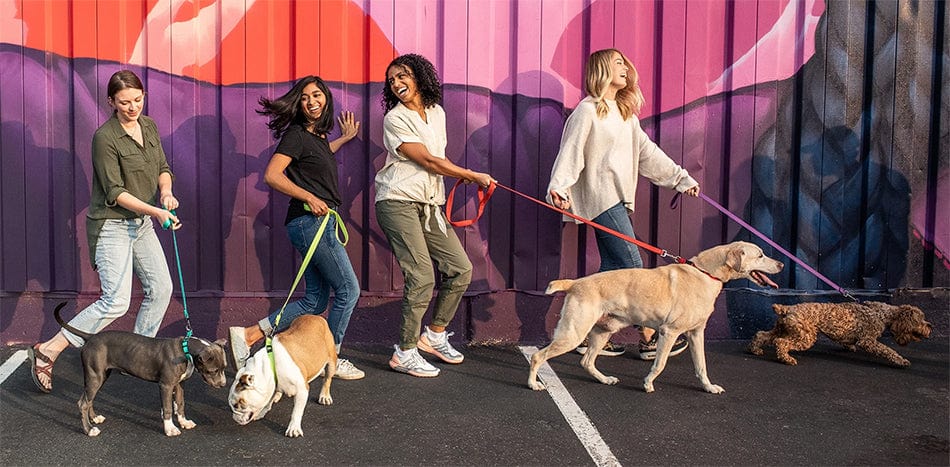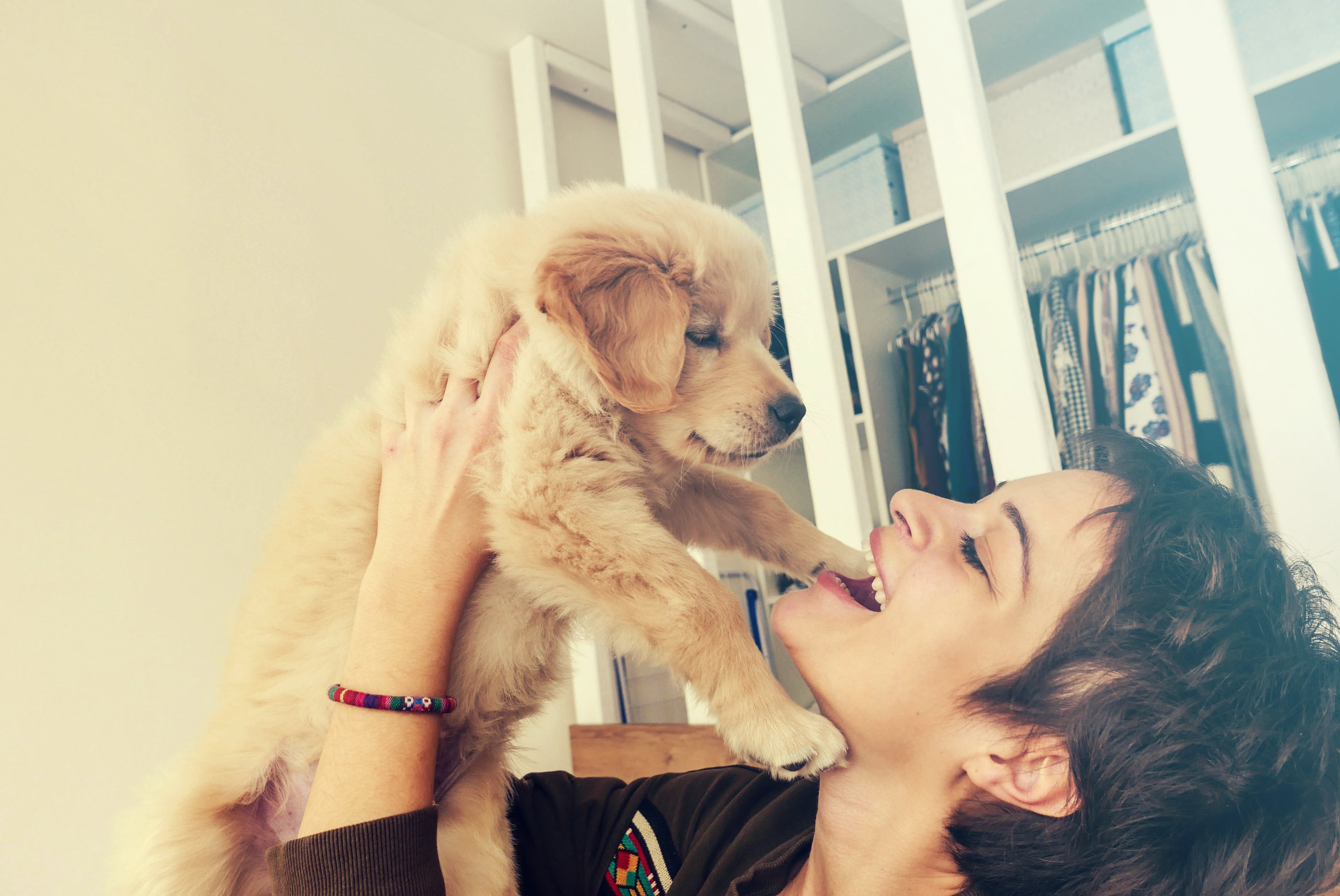Your cart is empty. Let's fix that!


Bringing home a new dog? Congratulations! It can be hard to remember everything you need to buy for your new addition—especially if it’s your first dog. We’re making it simple with a checklist!
There are a lot of unknowns when you bring home a new pet, but finding the right dog for you and making sure you have everything you need ready at home will have you as well prepared as possible! The last thing you need when your new puppy is crying all night long is to try to find a pet store that’s open at midnight to buy them a toy to cuddle.
With that being said, you don’t have to go overboard with purchasing every exciting product you see at the pet store! Instead, focus on these basics to get started. As you get to know your new dog and their personal preferences, you’ll be able to get them exactly the stuff they love, from their favorite toys to play with to the treat flavors that drive them wild.
Here’s what we recommend adding to your shopping cart before you pick up your new best friend:
Your new pooch may come home with a collar on, but basic shelter collars can be a little flimsy and it’s always good to spring for something sturdy when it comes to your pet’s safety!
A good collar is essential both to have somewhere to hang your pup’s ID tag and to clip a leash for a quick walk around the block. You can opt for something strong but simple or get fancy with reflective collars for safety, fun colors and patterns, or custom printing with your pet’s name and your phone number right on the collar.
While a collar may be enough for the trip home from the shelter, many vets and dog trainers recommend using a dog harness to walk your dog as much as possible. A harness provides more control than a simple collar, which dogs can slip out of or pull too hard on, potentially damaging their throat.
A well-fitted harness will be more secure and typically create a more comfortable walking experience for you and your dog! If you are getting a dog you think might pull (looking at you, eager puppies and wannabe sled dogs), consider getting a harness with a front clip that will redirect your dog if they pull and help to discourage the behavior.
Getting a good leash will make your life much easier! Standard dog leashes are typically around 6 feet long, which is a good length to allow your dog a little range of movement but also keep them close enough to rein them in when needed. Some leashes come with two handles, one at the end and one at a shorter length to allow you to keep a tight leash on your pooch when you’re steering them through a busy sidewalk.
You may choose to branch out and pick up a long leash for training or an extendable leash for more versatility after you get to know your dog’s personality and habits. Whatever leashes you choose, get one with sturdy clips to keep your dog secure. Keep your palms safe by operating for with comfortable handholds so you don’t get any leash burn when your dog books it after a squirrel!
A good dog carrier will make the trip home from the shelter and your upcoming vet visits much easier! It will also make car rides safer, keeping your pup contained and comfortable—some carriers can even be secured in place with your seatbelts.
Choose a carrier a few inches larger than your dog’s height and length so that they have room to stand, sit, and turn around. Some dogs enjoy the cozy, cave-like feeling of their carrier, which can help them feel more comfortable in stressful situations.
If your new dog doesn’t love being in their carrier or you want to give them a better view out the window, consider getting a car safety harness. Having your dog free roaming in the car is unsafe both for the driver and the dog themselves, and getting them used to a safety harness early can help prevent disaster if you’re ever in a car crash with your new best friend.
Dog car seats can work well for small dogs to secure them in place while boosting them up to give them a good view out the window—and a comfy place to snooze.
Dogs of any size can benefit from a safety-tested dog car harness that attaches to your car seatbelts. They do limit your dog’s mobility so they won’t be able to leap between the front and back seats, but they should still have enough range of motion to lie down, sit, stand, and look out the window.
The best bowls are ceramic or metal (plastic can scratch and hold bacteria), large enough to hold your dog’s full dinner, and have a wide and/or heavy base so they can’t be easily tipped over. Beyond that, it’s up to you whether you want to spring for a matching set of fancy dog bowls or pick up a couple of mixing bowls from the dollar store!
Finding the right dog food for your new pet can feel complicated, but a little research will make things easier. Look for a vet-recommended formula that’s filled with whole meat and vegetables—no byproducts or fillers. You should also make sure that it matches their stage of life, so look for puppy food, a senior recipe, or an all-ages formula that’ll suit every dog. We have a whole range of recipes designed with holistic veterinarian Dr. Angie to get you started!
Pro tip: ask the shelter what food they’ve been feeding your new dog and get a small bag so you can gradually transition them to your new food of choice.
When it comes to treats, choose a small variety for different occasions and to learn your dog’s preferences! We recommend getting some small dog training treats that are low-calorie enough to freely reward your dog with several during a training session as well as some chews like a bully stick or cow ear that will keep your dog entertained on lazy afternoons.
Don’t stress too much about picking the perfect food on the first try. You can keep experimenting with proteins and flavors of food and treats as you get to know your dog and find their favorite foods!
You can’t go wrong with a comfy dog bed! Even if your new dog prefers to snooze on the couch (or in your bed like ours do), it’s good for them to have a bed they know is all theirs whenever they want it. Look for a bed suited to your dog’s size that is machine washable or which has a washable cover for easy cleaning.
You may also consider getting a dog kennel or crate to house that bed! Whether or not you choose to crate train your dog, some dogs enjoy the enclosed, soothing space a kennel offers. Others prefer the open air, so provide them options as you get to know your dog’s preferences.
Whether you want to keep your dog in or out of certain areas of the house, a good dog gate (or baby gate pulled out of storage) will do the trick. Placed in doorways or at stairwells, they’ll keep your new friend contained exactly where you want them. Gates can be especially helpful as you get to know your dog (and their potential destructive tendencies) before you give them free rein over the whole house.
Choosing dog toys is where shopping for your new pooch gets really fun! While you definitely don’t have to have a full toy box waiting for your dog on day one, you should have a small variety of toys for them to choose from as you figure out their play style.
You’ll be covering all your bases if you get:
Make sure you choose the right toys for your dog! You’ll need smaller dog toys for small dogs, whereas large dogs will need large toys to prevent a choking hazard.
When it comes to chew toys, make sure you pick a dog-safe material like food-safe silicone or natural rubber. (Just say “no” to flaking plastic dog bones!) Look for an appropriate firmness for your dog’s teeth and play intensity—softer puppy chew toys for teething pups and tough dog toys for aggressive chewers.
Dog toys that are durable and easy to clean and sanitize are a huge plus! With proper care, your dog might still be cuddling up to their puppy toys when they’re a gray-muzzled senior.
Keeping your dog well groomed is important for their comfort—and for making sure you can leave the house without your clothes covered in dog hair. While you may choose to head to a professional groomer periodically for trims and other maintenance, there are some basic grooming supplies that every dog owner should have:
Check out our full guide to at-home dog grooming to find more details on how to use all these supplies and more!
The simple truth is that dogs can be messy! Good cleaning supplies are a well-known puppy essential, but dogs of every age can require an occasional cleanup crew. Even the tidiest dogs will track in mud on rainy days and you should be prepared for possible potty accidents when your dog is getting settled into their new home or has a stomach bug. Make sure you have:
Keep these basics together in a doggy cleaning kit you can stow in the closet or cabinet until it’s needed. Knowing you have everything you need ready to go will make tackling those “oh NO” kind of messes a little less scary!
Scooping poop isn’t a glamorous job, but all good dog owners have to roll up our sleeves and get the job done! Make it simple by getting dedicated dog poop bags so you’ll never be caught unprepared. You can opt for fancy poop scoopers or glove-shaped bags to make the job easier, but the poop bags we keep coming back to are sturdy, biodegradable, and come in bulk—you’re going to need a lot of them.
Are you bringing home a new senior dog? Help them settle into their forever home and enjoy their golden years with a few supplies just for them. You should consult the shelter on what your new dog’s unique needs are to see how you can best support them, but these are a few dog accessories that have helped our senior dogs live a fuller life:
Whether you’re bringing home a senior dog, adult, or puppy, this checklist will cover all the basics to keep them and you as comfortable as possible during the getting-to-know-you phase and for years to come! Congratulations on finding your new best friend—you’ve got a whole lot of love ahead of you.